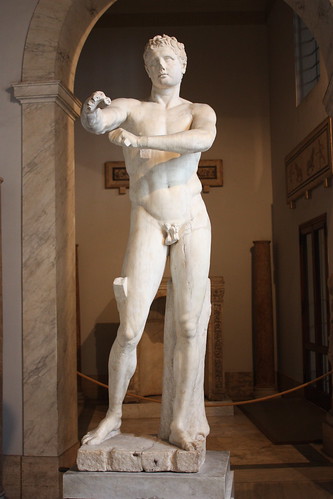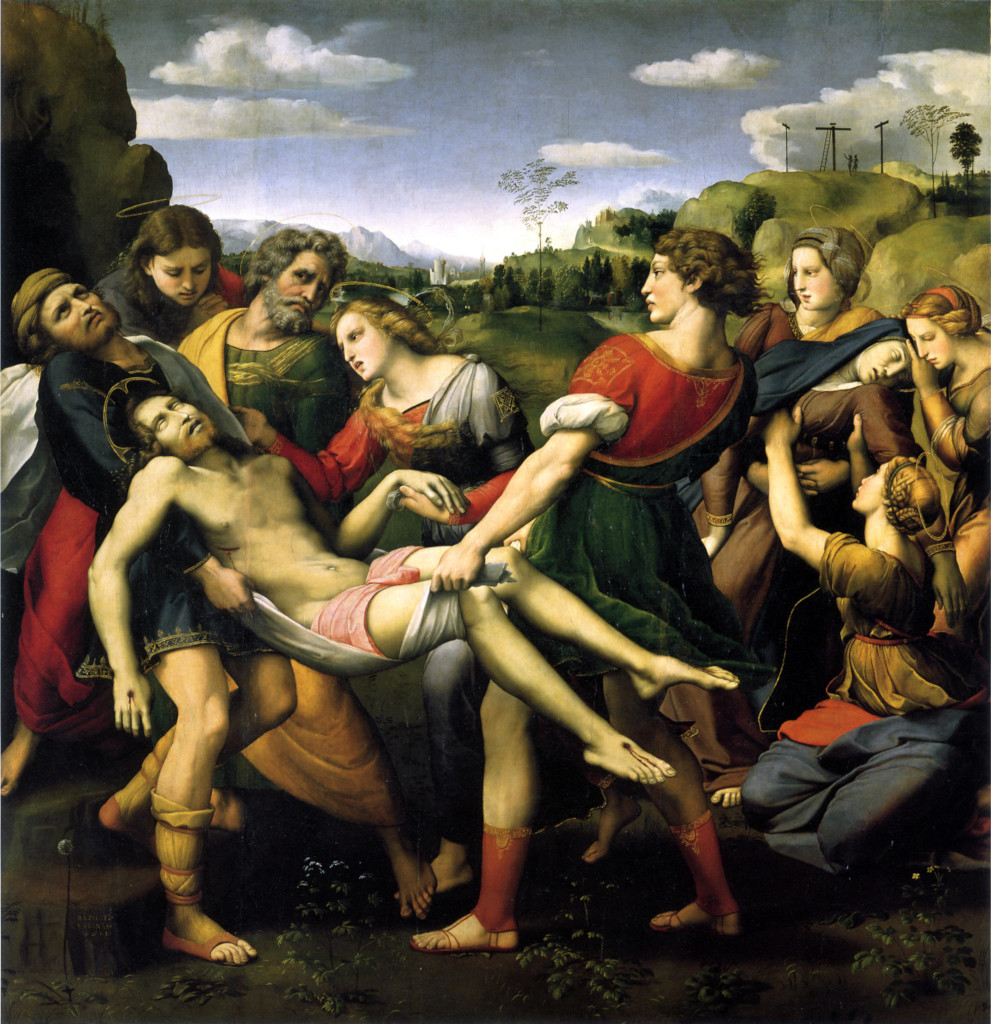Here we continue the portrait subject with Genay Sundra.
Wednesday, February 24, 2010
Further Thoughts on the Nude: The Relationship of the Contemporary to the Classical (Part 1/3)
Francis Cunningham
December 28, 2006
I am a classicist, that is to say a lover of the classical nude. But I have on occasion argued against the classical nude in order to free the model as subject – the “daily” nude, specific, naked and individual – so that I might discover the classical nude within the daily. How have I done this? By accepting the how-high-for-how-wide of the individual person’s proportions, the particularity of the arcs and angles that constitute his or her body’s shapes, and the particular color-value relationships that describe these shapes.
Francis Cunningham Patrick (1973-75), oil on linen, 80 x 44 in.
What appears on my canvas is not the result of copying nature. It is the product of a painterly process of decision-making, one that abstracts from the visual appearance of the figure and coordinates this information with the actual proportional relationships of the anatomical parts of the model’s body.
What our eyes see and what is actually there are not at all the same. Your eye may tell you that the hand coming toward you is larger than the head behind it – the camera gives proof – but your mind knows that the hand is smaller, and by how much.
The model in front of you may be lit by more than a single light source, perhaps by as many as four or five, but if you want the body’s forms to read as three-dimensional you will select a single light source and you will then light the geometrical form-concepts that mass the model’s anatomical parts by means of this single light source. All of this is knowledge, conceptual and generalized information which the artist brings to bear on the appearance of the particular model. What we “see” is a combination of seeing and knowing.
In taking up the nude today, what is the difference between now and what was done in the past? The short answer is a world. The disappearance of the classical world view has opened up for us a new world of possibilities in terms of the ways in which a human being moves and the meaning of gestures, and also in the means for creating three-dimensional form and space.
Jean Auguste Dominique Ingres La Grande Odalisque (1814), 35 x 64 in.
Classical art from antiquity through the 19th century was concerned primarily with ideal or idealized proportions, rhythms, pictorial organization and also with generalized color. The figures work as art, but how many classical or classicized figures do you know that can actually take a pose other than the one in which they are positioned? You may ask why would anyone want a painted or sculpted figure to be in any other position than the one they are in? Why should a painted or sculpted figure be anatomically functional and able to move about, change positions and take other poses? The answer to this is that in accepting the model as a functioning human being rather than just a painted or sculpted depiction, a whole new set of possibilities for understanding the human being, physically, mentally and spiritually, opens up – possibilities that were closed to the classical outlook.
Francis Cunningham Regina Reclining (2003-05), oil on linen, 32 x 65 in.
Francis Cunningham Genay Sundra Reclining (1997-99), oil on linen, 40 x 72 in.
How many depictions in classical painting and sculpture are other than theatrical, operatic statements of the “mad, sad, glad” of human emotions, as the chorographer Alwin Nikolais called them? Piero della Francesca’s silence is no less ideal in its effect – a theater of the ineloquent.
Piero della Francesca St. John the Evangelist (1454-1469), tempera on poplar panel, 52 3/4 x 24 1/2 in. The Frick Collection.
As an experiment, take Raphael’s Entombment and examine it for probability and expenditure of effort in relationship to the movement and gestures required by the action.
Raphael The Entombment (1507), oil on panel, 184 × 176 cm. Galleria Borghese, Rome.
Take each pose for yourself. You will not be able to. [I have had students prove this to themselves.] With this exercise in hand, examine the Sistine Ceiling and the Last Judgment of Michelangelo, the figures in Delacroix’s Death of Sardanapalus and Gericault’s Raft of the Medusa, with its Michelangeloesque poses in a carefully composed pyramid.
It’s not an accident that beginning with Praxiteles’ Aphrodite in the 4th century, classical antiquity developed only seven basic poses with minor variants for the goddess of love. Can we today imagine confining the expression of love to seven poses?
Francis Cunningham Regina (2005-2006), oil on linen 80 x 36 in.
The classical mindset from antiquity through the 19th century limited the possibilities of the nude to a small number of gestures and poses – these poses constitute the classical nude, as Kenneth Clark has described them in The Nude: A Study in Ideal Form.
Continues in part 2/3
December 28, 2006
Francis Cunningham Patrick (1973-75), oil on linen, 80 x 44 in.
What appears on my canvas is not the result of copying nature. It is the product of a painterly process of decision-making, one that abstracts from the visual appearance of the figure and coordinates this information with the actual proportional relationships of the anatomical parts of the model’s body.
What our eyes see and what is actually there are not at all the same. Your eye may tell you that the hand coming toward you is larger than the head behind it – the camera gives proof – but your mind knows that the hand is smaller, and by how much.
The model in front of you may be lit by more than a single light source, perhaps by as many as four or five, but if you want the body’s forms to read as three-dimensional you will select a single light source and you will then light the geometrical form-concepts that mass the model’s anatomical parts by means of this single light source. All of this is knowledge, conceptual and generalized information which the artist brings to bear on the appearance of the particular model. What we “see” is a combination of seeing and knowing.
In taking up the nude today, what is the difference between now and what was done in the past? The short answer is a world. The disappearance of the classical world view has opened up for us a new world of possibilities in terms of the ways in which a human being moves and the meaning of gestures, and also in the means for creating three-dimensional form and space.
Jean Auguste Dominique Ingres La Grande Odalisque (1814), 35 x 64 in.
Classical art from antiquity through the 19th century was concerned primarily with ideal or idealized proportions, rhythms, pictorial organization and also with generalized color. The figures work as art, but how many classical or classicized figures do you know that can actually take a pose other than the one in which they are positioned? You may ask why would anyone want a painted or sculpted figure to be in any other position than the one they are in? Why should a painted or sculpted figure be anatomically functional and able to move about, change positions and take other poses? The answer to this is that in accepting the model as a functioning human being rather than just a painted or sculpted depiction, a whole new set of possibilities for understanding the human being, physically, mentally and spiritually, opens up – possibilities that were closed to the classical outlook.
Francis Cunningham Regina Reclining (2003-05), oil on linen, 32 x 65 in.
Francis Cunningham Genay Sundra Reclining (1997-99), oil on linen, 40 x 72 in.
How many depictions in classical painting and sculpture are other than theatrical, operatic statements of the “mad, sad, glad” of human emotions, as the chorographer Alwin Nikolais called them? Piero della Francesca’s silence is no less ideal in its effect – a theater of the ineloquent.
Piero della Francesca St. John the Evangelist (1454-1469), tempera on poplar panel, 52 3/4 x 24 1/2 in. The Frick Collection.
As an experiment, take Raphael’s Entombment and examine it for probability and expenditure of effort in relationship to the movement and gestures required by the action.
Raphael The Entombment (1507), oil on panel, 184 × 176 cm. Galleria Borghese, Rome.
Take each pose for yourself. You will not be able to. [I have had students prove this to themselves.] With this exercise in hand, examine the Sistine Ceiling and the Last Judgment of Michelangelo, the figures in Delacroix’s Death of Sardanapalus and Gericault’s Raft of the Medusa, with its Michelangeloesque poses in a carefully composed pyramid.
Michelangelo The Sistine Ceiling; Cumaean Sibyl (detail).
Michelangelo The Last Judgment; St. Bartholomew (detail).
Delacroix Death of Sardanapalus (1827); detail.
Gericault’s Raft of the Medusa; detail.
Praxiteles Aphrodite
The classical mindset from antiquity through the 19th century limited the possibilities of the nude to a small number of gestures and poses – these poses constitute the classical nude, as Kenneth Clark has described them in The Nude: A Study in Ideal Form.
Continues in part 2/3
Wednesday, February 10, 2010
Philip Pearlstein/ Al Held Show's Belated NYT Review
In November we made a blog entry on the early reception of Philip Pearlstein/ Al Held "PEARLSTEIN/HELD: Five Decades" exhibition at Betty Cuningham Gallery, which was at the time on Dick's want-to-see list and also triggered my interest because of the video report by one of my favorite NY art voices, James Kalm. That was soon after show's opening, which Dick missed, but saw the show several weeks later. Here is the link to our original blog entry.
After time passed we thought that this exhibition might not be covered by the NYT. To our surprise, just three days before the scheduled closing a review by Roberta Smith made it to the Wednesday cover of the Arts as "last chance" here.
Some points of interest to Dick made by the reviewer were the way the two artist make three dimensional space on the flat surface of the canvas. Abstract and figurative art have been seen to be at war by misconceptions of how paintings are made and how they can create sensations of three dimensional space.
Dick goes into the subject of abstraction, form and space in his paintings in all of our videos on YouTube, but particularly in Designs within Design.
Pearlstein/ Held exhibition bridges the gap between figurative and abstract painting, well expressed by the reviewer, says Dick.
Labels:
abstraction,
artist,
held,
pearlstein,
representation
Portraits: Backgrounds
The father of Dick's current model, Stephanie, remarked on the variety of backgrounds for Dick's figures,
which often contrast the realism of the bodies. This remark made Dick think about the various abstract
and figurative backgrounds he's used. The following video shows examples of those backgrounds,
how they came to be used and how they work with the figure.
Portraits: Tom Johnson
Today we're posting another portrait. This time it's a model, Tom Johnson, whom Dick painted in four major works. The video tells the story of Tom, as Dick knew him, from before they met until Tom's death.
Tuesday, February 2, 2010
Design Within Design Cont.
About a week ago, we posted on Designs within Design and we heard from many of you. Dick realized that there is more to say on the subject of designs within the design as well as framing and composition and we made this follow up video.
Subscribe to:
Posts (Atom)













